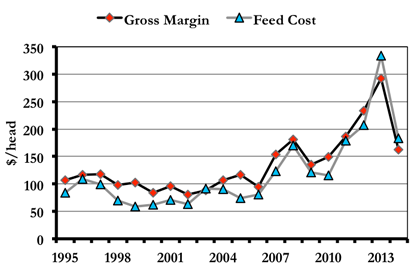Stocker to Feeder Scenarios

Taking a step back in time will help explain why stocker cattle are priced where they are.
By: Matthew Diersen, Professor & Risk/Business Management Specialist, SDSU Extension
A look back at past price relationship between cattle and feed may help explain the value of stocker cattle this time of year. This spring feed costs and the spread between stocker and feeder cattle changed substantially from a year ago with implications for several different prices. In May a stocker can be purchased in South Dakota and fed to gain 200 lbs. over a 4.5 month period. The sale value would be as a feeder-weight sold in September or the September feeder cattle futures price observed in May plus the basis for South Dakota.

The gross margin is calculated as the expected feeder price times 7.5 minus the spot stocker price times 5.5 with the basis assumed known with perfect foresight. The gross margin was only $135 per head as recently as 2009 and in 2013 was an unprecedented $292 per head (figure 1). In 2014 the September feeder futures contract price averaged $183 during April while the stocker price averaged $226. Assuming basis equals the five-year average for September of $5 implies a gross margin for 2014 of $163 per head after rounding.
What explains the size of the gross margin? The gross margin and feed cost are closely related; feed costs explained over 90% of the variability in the margin. A ration of 13.5 bushels of corn and a ton of hay (as-fed) is consistent with a stocker that gains 1.5 lbs. per day for 135 days. The cost of corn and hay can be found by using the NASS price during May for those commodities. From 1995 to 2012 there was a positive return after the feed cost in each year except 2003. The average return over that time span was $20 per head. During May of 2013 in South Dakota the price of corn was $6.87 per bushel and the price of hay was $241 per ton. That gave a feed cost of $334 per head, above the gross margin of $292 per head. During April of 2014 in South Dakota, the price of corn was $4.14 per bushel and the price of hay was $127 per ton. That gave a feed cost of $183 per head, again above the gross margin of $163 per head. While the levels move together, the positive returns of this scenario remain elusive.
As corn and hay prices change, they explain a portion of the gross margin. However, there seem to be several aspects at work affecting the relationship during the past two years. South Dakota calves may have had a higher value in other places. If other locations had cheaper feed, then the relationship is reflecting high demand for stockers. The quoted price of hay may not reflect the price or cost of the hay quality needed for growing a stocker. Alternatively, the quoted price may not reflect the transactions costs of buying and selling hay.
This May to September scenario is one of several followed to assess risk and rewards in the cattle complex. Implicit in the returns above is that the feeder cattle price is locked in, eliminating the risk. Looking back at the past 19 years, the unbiased nature of futures prices during this time could be questioned (figure 2). The September feeder cattle futures have increased in 13 years and decreased in 6 years from May to September. However, extreme moves up and down persistently show up, consistent with other scenarios.







